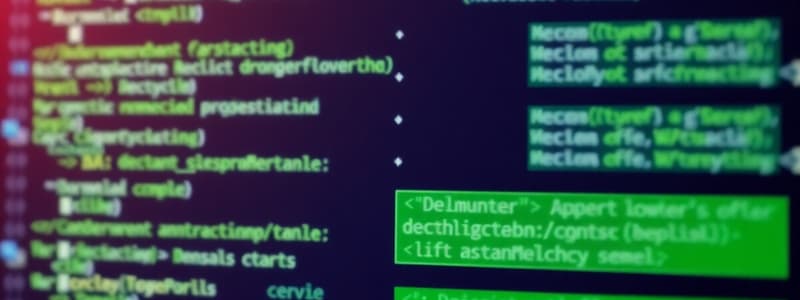Podcast
Questions and Answers
Domain classes are abstractions of key entities presented in the problem statement.
Domain classes are abstractions of key entities presented in the problem statement.
True (A)
The traditional techniques for identifying classes only focus on verbs in the problem statement.
The traditional techniques for identifying classes only focus on verbs in the problem statement.
False (B)
The grammatical approach to class identification was proposed by Grady Booch.
The grammatical approach to class identification was proposed by Grady Booch.
False (B)
Nouns that refer to entities and common nouns are likely candidates to map into classes.
Nouns that refer to entities and common nouns are likely candidates to map into classes.
The identification of classes can only be performed using English language problem statements.
The identification of classes can only be performed using English language problem statements.
Domain Models provide a conceptual understanding of the problem to aid in software design.
Domain Models provide a conceptual understanding of the problem to aid in software design.
Domain classes don't play a significant role in the analysis phase of software development.
Domain classes don't play a significant role in the analysis phase of software development.
Identifying the classes comes after implementing all the logical flows of the system.
Identifying the classes comes after implementing all the logical flows of the system.
Same nouns can refer to different concepts.
Same nouns can refer to different concepts.
Identifying domain classes is always straightforward for novices.
Identifying domain classes is always straightforward for novices.
The article mentions a paper that discusses a taxonomic class modeling methodology.
The article mentions a paper that discusses a taxonomic class modeling methodology.
The concepts presented are intended to make it difficult for students to understand the subject.
The concepts presented are intended to make it difficult for students to understand the subject.
It is suggested that interested readers can refer to the bibliography for advanced treatments on domain classes.
It is suggested that interested readers can refer to the bibliography for advanced treatments on domain classes.
The problem statement always helps in correct identification of a class.
The problem statement always helps in correct identification of a class.
Using generalization involves classifying potential objects into different groups based on common behavior.
Using generalization involves classifying potential objects into different groups based on common behavior.
Filtering out redundant classes is an unnecessary step in identifying domain classes.
Filtering out redundant classes is an unnecessary step in identifying domain classes.
The first step in identifying domain classes involves making a list of potential objects using verbs.
The first step in identifying domain classes involves making a list of potential objects using verbs.
Events are defined as things that happen, usually at a specific date and time.
Events are defined as things that happen, usually at a specific date and time.
Concepts are tangible principles or ideas.
Concepts are tangible principles or ideas.
Grouping objects based on similar attributes is an important step in the identification process.
Grouping objects based on similar attributes is an important step in the identification process.
Different nouns can refer to the same entity, such as 'home' and 'abode'.
Different nouns can refer to the same entity, such as 'home' and 'abode'.
Flashcards
Domain Classes
Domain Classes
Business concepts represented as classes in a system.
Textual Analysis
Textual Analysis
Identifying domain classes from natural language text.
Domain Model
Domain Model
A visual representation of domain classes and their relationships.
Iterative Refinement
Iterative Refinement
Signup and view all the flashcards
Class Identification
Class Identification
Signup and view all the flashcards
Grammatical Approach
Grammatical Approach
Signup and view all the flashcards
Noun Identification
Noun Identification
Signup and view all the flashcards
Potential Classes
Potential Classes
Signup and view all the flashcards
Problem Statement
Problem Statement
Signup and view all the flashcards
Object-Oriented Paradigm
Object-Oriented Paradigm
Signup and view all the flashcards
Use Cases
Use Cases
Signup and view all the flashcards
Identifying Domain Classes
Identifying Domain Classes
Signup and view all the flashcards
Problem Statement Limitations
Problem Statement Limitations
Signup and view all the flashcards
Generalization Approach
Generalization Approach
Signup and view all the flashcards
Subclass Approach
Subclass Approach
Signup and view all the flashcards
Nouns for Class Identification
Nouns for Class Identification
Signup and view all the flashcards
Domain Expertise
Domain Expertise
Signup and view all the flashcards
Redundancy Filtering
Redundancy Filtering
Signup and view all the flashcards
Categorizing Objects
Categorizing Objects
Signup and view all the flashcards
Study Notes
Identifying Domain Classes from Problem Statements
- Identifying domain classes is crucial in object-oriented programming, as classes represent the structural units of a system.
- Understanding the classes beforehand is vital in implementing system logic.
- The lecture focuses on identifying classes from a given problem statement.
Objectives
- Learners will understand the concept of domain classes.
- Learners will identify potential domain classes from a given problem statement.
Domain Class
- In object-oriented models, domain object models are significant for effectively understanding and addressing problems.
- Domain models serve as conceptual models for proper problem insight.
- Core components are domain classes.
- Domain classes abstract key entities, concepts, or ideas in problem statements.
- These classes represent business activities in the analysis phase.
Traditional Techniques for Identifying Classes
1. Grammatical Approach Using Nouns
- This approach, popularized by Russell J. Abbot and Grady Booch, uses grammatical analysis of the problem statement to identify potential classes.
- Steps involve:
- Obtaining a descriptive English problem statement (use case diagram).
- Identifying nouns, pronouns, and noun phrases.
- Listing potential classes based on noun categories (e.g., people, places, things, organizations, concepts, events).
Advantages
- Easy to understand and apply.
- Doesn't necessitate the problem statement to be in English.
Disadvantages
- Problem statements might not always lead to accurate class identification.
- Redundant classes or classes representing aggregates of other classes might be identified.
2. Using Generalization
- Classes are derived based on common behaviors of objects.
3. Using Subclasses
- Identifying classes based on similar characteristics.
- Creates specialized classes that contribute to generalized classes.
Steps to Identify Domain Classes from a Problem Statement
- Create a list of potential classes by identifying nouns and noun phrases in the narrative problem statement.
- Experts or domain knowledge can be used to identify additional classes.
- Eliminate redundant or irrelevant classes.
- Classify potential objects based on predefined categories.
Categories for Potential Domain Classes
-
People: Individuals performing functions.
-
Places: Areas specific for people or things.
-
Things: Physical objects.
-
Organizations: Collections with defined missions.
-
Concepts: Ideas or principles.
-
Events: Occurrences at specific times/steps in an ordered sequence.
-
Repeated or similar nouns or noun phrases may represent the same thing or different things depending on context.
-
Finalize top-level classes by giving names to identified object groups and refine the list.
Advanced Concepts
- Defining domain classes may require specialized knowledge.
- Identification relies on domain expertise for effective class definition from English text.
Studying That Suits You
Use AI to generate personalized quizzes and flashcards to suit your learning preferences.




